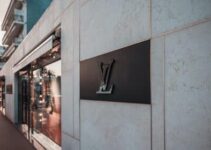In June, Apple unveiled its widely-anticipated mixed reality headset, the Vision Pro. The first wearable headset device to arrive from the company, it boasts spatial audio functionality, ultra high-resolution display systems, and AI-enabled eye-tracking features for navigation.
There was just one fatal flaw: its design was egregiously uncool.
“I want to see Tim Cook in the nerd goggles now,” one user penned on X.
Within hours of its release, the product had been ‘memeified’ by the fashion community. One meme published by popular Instagram user @sainthoax that quipped “Apple is in its Black Mirror era” accumulated over 150,000 likes.

Apple’s Vision Pro mixed reality headset captured the fashion communities attention, but for all the wrong reasons. Photo: Apple
Tech-forward era
The tech industry has fought and failed to find its place in fashion for decades. But the climate is shifting.
“As the world becomes a wearable world, fashion will not only be transformed, but will be a leading catalyst for adoption,” Cathy Hackl, chief futurist at Journey and spatial computing expert tells Jing Daily.
Where some products have succeeded, like Apple’s AirPods Max, which made waves on TikTok this year, riskier concepts like the Vision Pro and Oculus Quest have fallen short.
Mark Zuckerberg’s Meta is now trying to change the narrative. Last week, the tech conglomerate unveiled its next generation of augmented reality (AR) powered smart glasses in partnership with global eyewear leader Ray-Ban.

Meta is leveraging its mass appeal by teaming up with Ray-Ban on its AR-powered eyewear. Photo: Meta
“Are the Ray-Ban Meta smart glasses finally cool?” Esquire Singapore asked following the release. Borrowing Ray-Ban’s classic silhouette, but in new colorways, the smart glasses allow users to livestream via Facebook and Instagram, as well as capture photos and audio, among various other functions.
Each pair arrives with a sleek leather charging case, a premium alternative to the typical charging wire.
As fashion enters a new tech-forward era, propelled by the popularization of Web3 and artificial intelligence (AI), industry players are lending their brand power to major tech companies to ride on the zeitgeist.
“Tech and fashion attract similar levels of fervor and a relationship between the two will be mutually beneficial,” Matt Zara, consumer technology trend forecaster and editor at WGSN, tells Jing Daily. “By creating products that people want to wear and display, both industries benefit from a boost in brand awareness.”

The LG x Prada phone, alongside its matching Bluetooth watch. Photo: campaignlive
A long history
Attempts to marry tech and high fashion aren’t new. James Bond’s Omega Seamaster wristwatch, which packs a laser, made its first official appearance in 1995, while Zara points to LG and Prada’s collaboration in 2007 that produced a phone that has “become a cult classic among the tech-fashion initiated.”
But there have been misses, too.
In 2014, New York Times fashion critic Vanessa Freidman branded the Apple Watch the star of the show at Paris Fashion Week. Jony Ive, then Apple’s chief design officer, flew to the French capital to persuade the fashion crowd that the smart watch was the future.
Today, while over 100 million people are said to own an Apple Watch, the product hasn’t taken off among fashion lovers.
That isn’t to say Apple hasn’t tried. The tech conglomerate has since 2015 had a longstanding relationship with storied French fashion house Hermès.
The pair launched its latest product last month, an Apple Watch strap that deploys the luxury maison’s trademark ‘Orange H’ hue, as well as woven band designs inspired by Hermès’ signature checked canvas.
But eight years on, the first-of-its-kind partnership has not produced enough sartorial flair to convince style-centric consumers.
The tech industry tried again for Spring/Summer 2024 fashion month.

Hermès x Apple’s collaboration aims to bring Apple Watches to the luxury fashion market. Photo: Hermès
Stamp of approval
For its SS24 collection, Coperni sent reigning 1990s supermodel Naomi Campbell down the runway in a black blazer ensemble. Attached to the lapel was a blink-and-you’ll-miss-it AI pin, designed by San Francisco startup Humane (whose founders are both former Apple execs).
While the gadget’s official use-case hasn’t been fully divulged, it got the online fashion community talking – this time, unlike the Vision Pro, for all the right reasons.
As a relative newcomer to the fashion scene, Coperni has carved out a space in the luxury fashion sector by championing technology in both its design concepts and marketing strategies.
The brand has teamed up with tech companies like Boston Dynamics, Transparent Speaker, and Humane on the runway to combine style and science. It’s paying off – according to an interview with the brand’s founders in March, Coperni’s sales have doubled every season since 2021.

Humane’s AI-enabled pin made its debut on the Coperni SS24 runway. Photo: LinkedIn
In Meta’s case, the company aims to generate mass appeal by getting the stamp of approval from a respected label like Ray-Ban.
As Meta expands its demographic beyond white collar workers and tech proponents, partnering with a recognized label like the eyewear behemoth is helping amplify its cultural relevance.
Borrowing style codes from a fashion staple like Ray-Ban may be a step in the right direction. But there’s still a long way to go before wearables like AR-enabled smartwear go mainstream.
“VR headsets and AR eyewear can act as status symbols, signaling to other enthusiasts that you’re ‘in the know,’” Zara says. “However, before we see people wearing these devices out in public, I think they’ll need to become more streamlined and less clunky to avoid awkward stares from passers-by.”

Gucci teamed up with wearable fitness tech company Ōura on a health-tracking ring last year. Photo: Gucci
What is cool, anyway?
In today’s high fashion market, what constitutes ‘cool’ is as much of a myth as it is the driving force behind the industry.
The AirPods Max earned its rep by capturing the attention of internet ‘it’ girls. American socialite and fashion influencer Devon Lee Carlson was one of them.
With over 2 million followers on Instagram and 806,000 on TikTok, the social media sensation was one of the first to endorse the headphones (alongside a bevy of stars including Justin Bieber and Bella Hadid) before creating a line of AirPods Max covers via her iPhone accessories company, Wildflower Cases.
The cover designs tap into Gen-Z’s thriving “core” trends such as ‘coquette’ and ‘indie sleaze,’ sending the product on an upwards trajectory to mainstream success among younger audiences. The hashtag #airpodsmaxcovers has amassed over 2.4 million views on TikTok to date.

Carlson’s Wildflower Cases accessories brand brought Apple’s AirPods Max to the forefront of Gen-Z culture. Photo: Wildflower Cases
Elsewhere, tech startups are eschewing the traditional company roadmap to leverage their ‘cool kid’ status.
They’re adopting fashion-native tactics to court style-savvy consumers over ‘tech bros.’ Zara cites the emerging UK-based tech label Nothing, known for its transparent aesthetic, as an example.
“Nothing, founded by Carl Pei, the co-founder of OnePlus, has been smart by seeding its products to popular streetwear and lifestyle influencers around London. It’s also held in-person ‘drops’ for new product releases, bringing together brand enthusiasts and building hype,” Zara says.
The approach is working, with publications like British culture mag The Face coining Nothing as “fashion’s favorite tech brand.” Asian American designer Chet Lo featured the startup’s earphones on his SS23 runway.

UK-based tech company Nothing is targeting the high fashion crowd over traditional tech proponents. Photo: Nothing
Future convergence
While the tech market has always been in luxury’s periphery, and vice versa, a more close-knit alliance is on the horizon.
“Whether the future is on our faces or our lapels, we’ll see a lot of competition in the spatial computing wearables market over the next few years as more companies look at what will replace the smartphone. These devices are the key to new ways to interface with technology,” Hackl says.
Both sectors are taking note, with Zuckerberg having been spotted mingling with industry hotspots at fashion week showcases to boost Meta’s style credibility.
This recent push is reflective of a changing landscape where developments like Web3, virtual reality (VR), AR, and AI are playing a bigger role in fashion than ever before.
But will we see more wearables grace the runway, and arguably more importantly, the streets? Zara thinks so.
“It’s a trend we’ve seen before, and I’m sure it’s something we’ll see again,” he says. “The further tech creeps into our everyday lives, style-conscious people will seek ways to stand out. Wearables such as AR glasses and smartwatches are two areas of real opportunity.”


